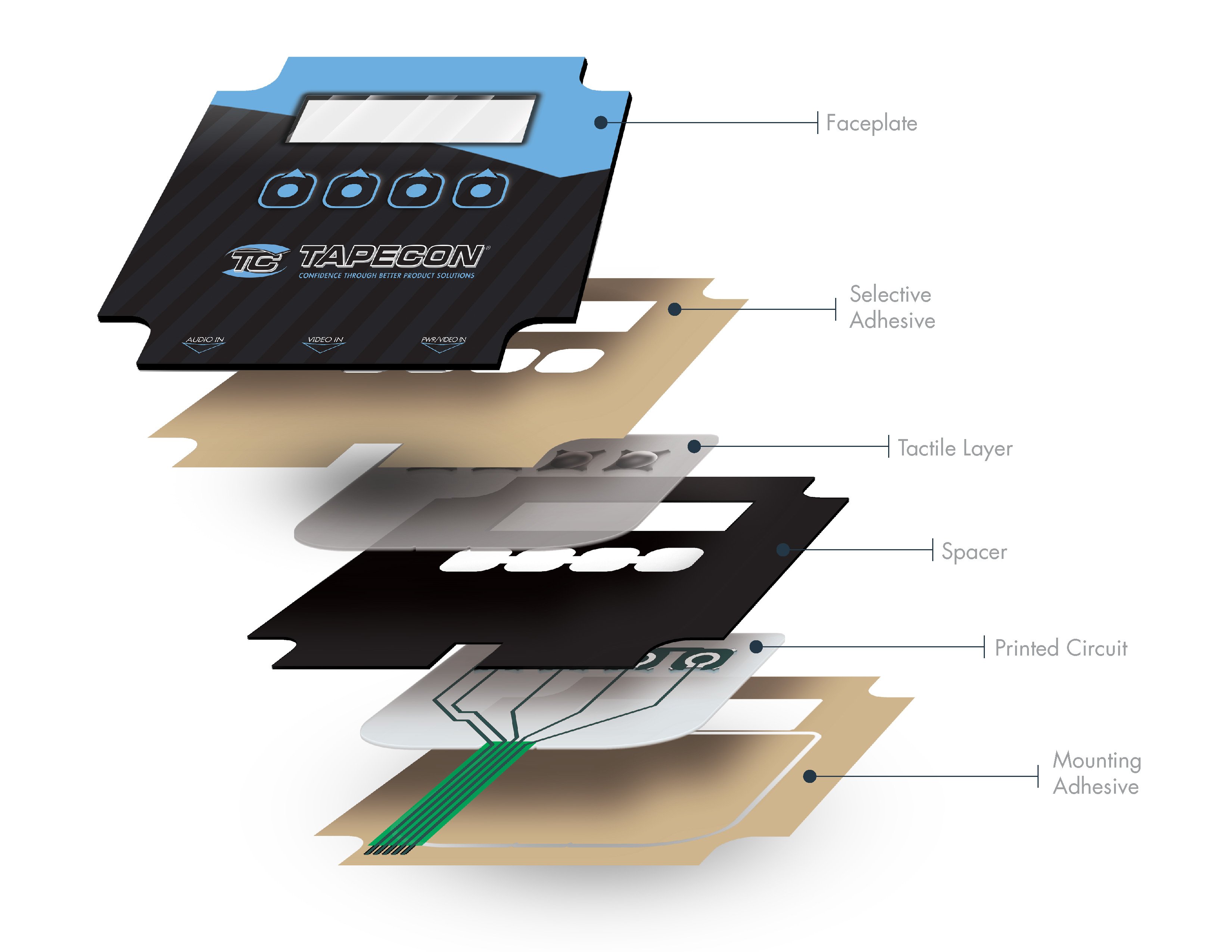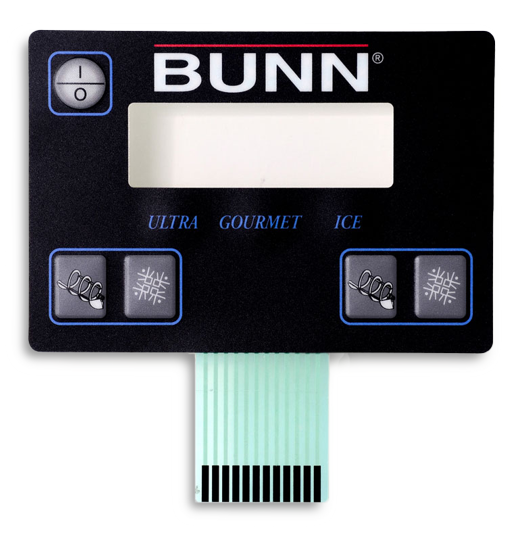Modern Technology from a Top Membrane Switch Manufacturer
Wiki Article
Discovering the Manufacturing Refine of Membrane Switch for Various Industries
The manufacturing process of Membrane buttons is a complex undertaking that demands precision and focus to information. From choosing appropriate materials to applying rigorous top quality control actions, each step plays an important duty in guaranteeing functionality. Different sectors, consisting of clinical and auto, rely upon these elements for their unique applications. Comprehending the complexities of this process exposes significant insights into how these buttons are produced and their effect across diverse industries.Recognizing Membrane Changes: An Introduction

Trick Products Utilized in Membrane Switch Manufacturing
In Membrane button production, the selection of crucial materials substantially influences capability and resilience. Conductive products, adhesives, and layers play crucial functions, while substratum choice influences total performance and dependability. Understanding these parts is vital for maximizing the design and production of Membrane buttons.Conductive Materials Summary
Conductive products play an important function in the functionality of Membrane buttons, guaranteeing reputable electric links within the tool. Typically used products include silver, copper, and carbon-based inks, each offering unique advantages. Silver is preferred for its high conductivity and sturdiness, making it optimal for applications needing durable performance. Copper, while slightly much less conductive than silver, is a cost-efficient alternative commonly made use of in printed circuits. Carbon-based inks offer a functional alternative, suitable for applications where versatility and lower costs are prioritized, although they have actually reduced conductivity compared to metal choices. The option of conductive products straight impacts the general reliability, lifespan, and efficiency of the Membrane switch, making it an important factor to consider in the manufacturing procedure.Adhesives and Coatings
Adhesives and layers are important parts in the manufacturing of Membrane buttons, offering vital bonding and safety homes. These materials ensure that numerous layers of the button, consisting of visuals overlays and wiring, adhere securely to one another, enhancing sturdiness and functionality. Commonly utilized adhesives consist of pressure-sensitive adhesives (PSAs) and epoxy-based formulations, which supply strong attachment and durability. Coatings, such as polyurethane or acrylic, offer to secure against ecological factors, including wetness, abrasion, and chemicals. Furthermore, coatings can improve responsive feedback and aesthetic charm, adding to the general customer experience. The option of proper adhesives and finishes is crucial for optimizing performance and durability in diverse applications across numerous sectors, ensuring that Membrane switches over satisfy specific functional demands.Substrate Selection Factors
Substratum option plays a crucial duty in the production of Membrane buttons, as it substantially affects their general efficiency and resilience. Key products such as polyester, polycarbonate, and adaptable printed circuit card (FPCBs) are generally used for their distinct buildings. Polyester is favored for its cost-effectiveness and resistance to abrasion, making it appropriate for applications with high wear. Polycarbonate offers premium quality and influence resistance, perfect for environments requiring high visibility. FPCBs offer improved versatility and are commonly made use of in complicated layouts. The selection of substratum also influences factors like thermal security, chemical resistance, and simplicity of printing. Eventually, selecting the appropriate substrate is important for guaranteeing the capability and durability of Membrane switches throughout various markets.The Style Refine of Membrane Switches
The style procedure of Membrane switches is a vital stage that considerably affects the capability and appearances of the last product - membrane switch manufacturer. It begins with defining the specific needs of the application, consisting of dimensions, switch layout, and tactile feedback choices. Designers should think about customer interaction, making certain that the switch is intuitive and accessible.Next, materials are picked based upon durability, adaptability, and environmental resistance. The integration of graphics and branding aspects is additionally important, as it enhances aesthetic allure and communication. Prototyping permits iterative screening, making it possible for changes based upon individual comments and performance evaluations.Additionally, the design must represent the electric parts, such as adapters and circuits, guaranteeing reliability and convenience of use. Eventually, an effective layout harmonizes capability, looks, and customer experience, leading the way for reliable production and long-lasting efficiency in different marketsPrinting Methods for Membrane Changes
The printing strategies made use of in Membrane switch production play an essential role in identifying the final item's quality and performance. Screen printing provides advantages such as toughness and lively shade application, while electronic printing technologies give flexibility and precision in layout. Understanding these approaches can substantially influence the general efficiency of Membrane switches in numerous applications.Screen Printing Benefits
Numerous advantages make screen publishing a favored technique for producing Membrane buttons. This technique permits high-grade, in-depth styles and vivid colors, which are important for user interface applications. Screen printing is particularly efficient for using thick ink layers, enhancing toughness and responsive feedback. Additionally, it provides excellent attachment to different substratums, guaranteeing longevity he has a good point popular environments. The procedure is cost-effective for huge production runs, as it reduces setup time and waste. Screen printing supports a large variety of inks, including specialty and UV-curable choices, allowing adaptability in layout. Its ability to generate regular outcomes throughout several systems makes it a trustworthy choice for suppliers intending for top quality and effectiveness in Membrane switch production.
Digital Printing Innovations

Developments in digital click to read printing technology are transforming the manufacturing of Membrane buttons, supplying makers cutting-edge options that boost design flexibility and performance. Digital printing permits for high-resolution graphics and intricate styles, allowing custom branding and performance without the restrictions of conventional approaches. This method decreases setup times and costs, facilitating much shorter production runs and minimal waste, making it ideal for organizations with varying needs. In addition, advancements in ink formulas give better toughness and bond, guaranteeing durability in various environments. As markets progressively seek complicated and personalized designs, electronic printing stands apart as a crucial technique, establishing a new requirement in Membrane button manufacturing. The assimilation of these technologies settings makers to fulfill developing market requires efficiently.
Setting up and Layering of Membrane Switch Parts
Mindful assembly and layering of Membrane switch components are important to assuring functionality and longevity. This procedure starts with the precise placement of various layers, consisting of the visuals overlay, sticky, circuit layer, and backing material. Each part has to be carefully positioned to preserve electrical honesty and customer interface responsiveness.During assembly, conductive traces are applied to the circuit layer, typically made from products like polyester or polycarbonate. This layer is critical, as it beams when stress is used. The adhesive utilized for bonding these layers is likewise picked for its capability to endure environmental tensions while maintaining a safe and secure bond.Heat and stress are usually applied during the assembly process to establish that the layers stick properly without endangering the capability of the switch. Ultimately, attention is provided to the side securing to protect against dampness and pollutants, safeguarding the long life of the Membrane switch in various commercial applications.Quality Assurance Measures in Membrane Switch Manufacturing
Quality control procedures play an essential function in guaranteeing the reliability and efficiency of Membrane switches over adhering to the setting up and layering of their components. In the manufacturing procedure, several vital assessments are carried out to maintain high quality criteria. These consist of visual assessments for issues in printing and sticky application, along with practical examinations to validate the responsiveness of each switch.Additionally, ecological testing is carried out to assess the buttons' durability versus temperature level changes and moisture direct exposure. Producers commonly execute statistical process control (copyright) strategies to keep track of production consistency, making it possible for very early detection of anomalies.Furthermore, traceability systems are established to track materials and elements, making sure liability and facilitating remembers if necessary. Calibration of devices and adherence to market standards are likewise essential to preserving item integrity. Collectively, these quality assurance measures guard the efficiency of Membrane switches throughout numerous applications, inevitably boosting consumer contentment.Applications of Membrane Switches Throughout Different Industries
Membrane buttons are made use of throughout a varied array of markets, showcasing their flexibility and flexibility. In the clinical sector, they give water resistant and trustworthy user interfaces for gadgets such as analysis tools and infusion pumps, ensuring hygiene and ease of use. The vehicle market employs Membrane buttons for dashboard controls, making it possible for seamless communication in between the chauffeur and automobile systems.In customer electronics, these switches are located in home appliances and handheld devices, providing a streamlined, modern-day visual while boosting performance. Industrial applications likewise utilize Membrane switches over for machinery control panels, where sturdiness and resistance to severe problems are essential.Furthermore, the aerospace and defense fields make use of Membrane buttons for cabin instrumentation and communication systems, prioritizing reliability and performance under extreme conditions. On the whole, Membrane buttons play an important function in boosting the customer experience and operational efficiency across numerous domains.Regularly Asked Concerns
How Long Does It Require To Make a Membrane Switch?
The production time for a membrane button usually varies from a few days to a number of weeks - membrane switch review manufacturer. Variables influencing this duration consist of design intricacy, product accessibility, and production volume, all impacting the overall timeline markedlyWhat Is the Typical Life Expectancy of a Membrane Layer Switch?
The regular lifespan of a membrane layer switch typically ranges from 1 to 5 million actuations, relying on variables such as material high quality, environmental conditions, and use regularity, greatly affecting durability and general efficiency.Can Membrane Switches Be Customized for Certain Applications?
Membrane buttons can indeed be customized for details applications. Their layout versatility permits modifications in dimension, shape, colors, and graphics, making certain compatibility with special requirements throughout various markets and boosting performance and customer experience.
Are Membrane Changes Ecologically Friendly?
The ecological impact of Membrane switches over varies. Some products utilized may not be environment-friendly, while innovations in manufacturing procedures are increasingly concentrating on sustainability, aiming to minimize waste and promote recyclable components in their production.What Are the Typical Failure Modes of Membrane Buttons?
Typical failing settings of Membrane buttons consist of delamination, adhesive failing, wear and tear from usage, moisture access, and electric failings. These problems can significantly influence performance, efficiency, and life-span in numerous applications across different markets. Membrane buttons can be customized to fit specific design demands, such as size, capability, and form, making them very adaptable.The construction generally involves several layers, including a graphic overlay, sticky, and a circuit layer, which work together to produce a smooth individual experience. In Membrane button production, the option of vital products considerably affects capability and toughness. The automotive sector utilizes Membrane buttons for dashboard controls, allowing smooth communication between the motorist and automobile systems.In customer electronics, these switches are found in appliances and handheld devices, using a streamlined, contemporary aesthetic while enhancing performance. Industrial applications additionally leverage Membrane switches over for machinery control panels, where toughness and resistance to rough problems are essential.Furthermore, the aerospace and protection markets use Membrane buttons for cockpit instrumentation and communication systems, prioritizing integrity and efficiency under extreme problems. Membrane buttons can without a doubt be customized for certain applications.Report this wiki page